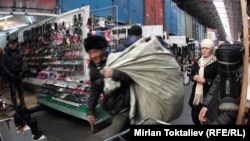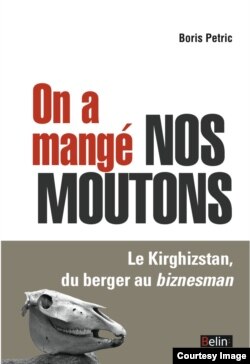
"Qishloq Ovozi" is pleased to once again introduce one of the up-and-coming talents in the field of Central Asian studies. This time we meet Nari Shelekpayev, who reviews a book by Boris Petric titled "On a mangé nos moutons: le Kirghizstan, du berger au biznesman" or "They Ate the Sheep: The Kyrgyz, from Shepherd to Businessman," which examines the foundations of Kyrgyz society in the years of independence from the point of view of "the historian or anthropologist."
The field of Central Asian studies is not oversaturated with publications. Among the few books and articles that appear every so often, a majority of the publications relate to political science and/or international relations, whereas relatively few are produced by historians or anthropologists.
For this reason alone, Boris Petric's book deserves some attention. The fruits of a decade of labor, this is original research presented by a scholar who knows Kyrgyzstan from the inside out (he says he speaks Kyrgyz and Russian) and may as such contribute to a better, nonfiction understanding of this Central Asian country and the peculiarities of its economic and political systems. On the other hand, Petric perspicaciously questions a number of "universal" cliches, such as "good governance," "globalization," and "state," thus trying to classify his book exclusively into Central Asian studies would perhaps be an oversimplification. In sum, an intelligent proportion of the local and the global, coupled with a simplicity of the narrative, makes reading Petric's book a rather enjoyable exercise.
Several times I found myself questioning whether the author deliberately avoids any kind of frameworks or theoretical generalizations. Whether depicting a complicated north-south relationship in Kyrgyzstan, or the intersection of Chinese, Russian, and American interests as external influences, Petric does not attempt to apply to them a "clash of civilizations" or an "imagined community." Likewise there is no a trace of a "liquid modernity" or a "microphysics of power" in the Kyrgyz bazaars and NGOs which are the central node (or the main protagonists?) of Petric's investigation. Bibliographical references are minimal. On the other hand, the author describes in details who and under what circumstances he met and talked to, and how the trajectory of his research had been transformed.
It happened that the years of Petric's survey coincided with a series of dramatic events in post-Soviet Kyrgyzstan's political history. However, although various political issues occupy an important place in the book, the two revolutions, that of 2005 and another one five years later, were mentioned briefly and artlessly. Indeed, what really interests Petric are not the events and politics as such, but the practice and the tactics of their production in post-Soviet Kyrgyzstan.
Economically, Kyrgyzstan hardly benefited from the collapse of the Soviet Union. In fact, during the 1991 referendum on the future of the Soviet Union, 96 percent of its population voted to remain in the union. Petric points out that independence was not perceived by the majority of the Kyrgyz population as a victory over Russia. After 1991, deindustrialization, caused by the collapse of economic relations with the former U.S.S.R. countries, combined with extensive neoliberal reforms (Kyrgyzstan joined the WTO in 1997, before the Baltic states, Russia, or Ukraine) resulted in the decline of a productive economy and made Kyrgyzstan dependent on its neighboring countries.
A part of the population began to create small-scale trading companies; thus the term "biznesman," employed by Petric, has been appropriated by Kyrgyz society. At the same time, another part of the population emigrated to Kazakhstan and to Russia for seasonal or permanent work. As for the Kyrgyz state, it evolved, according to Petric, into a "traffic territory," dependent on the income generated from Chinese imports and their subsequent resale to the neighboring countries. Another source of income became international aid, provided and redistributed by numerous international governmental and nongovernmental agencies. These two phenomena, traffic territory and international agencies represented by their agents, are the central themes of the book.
A Kyrgyz bazaar (Dordoi bazaar is depicted in detail, but others are mentioned as well) is a well organized economic territory where no form of anarchy is possible, argues Petric. De-exoticized and hierarchized, the physical and psychological space of the bazaars is an essential part of Kyrgyz society. It is a place where encounters and exchanges take place; where one can easily find temporary and/or permanent work, and both political and financial capitals are created. In short, the bazaar is a new alternative "locus" of power "a la kirghyze."
Another such site of power is dispersed among numerous foreign organizations settled in Kyrgyzstan. The money derived from international institutions is spent on various projects by international civil servants and local NGOs. But the goal of so-called development aid is sometimes questionable. Aiming to promote democracy and "good governance," some international organizations and NGOs are far from being neutral and interfere overtly in the internal political affairs of Kyrgyzstan. Thus, according to Petric's investigation, the OSCE manipulated the prioritizing of information techniques, and as such contributed to a delegitimization of the parliamentary elections organized by the former president, Askar Akaev. Subsequently, the same agencies helped to legitimize the presidential elections organized by Akaev's opponent, Kurmanbek Bakiev.
Petric portrays the men and the women whose interests and ideas buttress each institution. These ideas and interests may be a consequence of clientelist relations, ideology, and/or strategies of the states these actors come from. Sometimes they have their own ideas about how the situation in the country should develop. Therefore, another contribution of Petric's book is to show that the so-called NGO-ization of Kyrgyzstan is not a spontaneous awakening of a civil society; rather it is a result of intense interactions between global and local actors.
Kyrgyzstan is a territory where the interests of great powers intersect. But what would be then the role of the Kyrgyz state vis-a-vis these interests? Devoid of a possibility to define the rules of the game, does it simply try to ensure itself a presence in the polyphony or the co-construction of others' strategies?
Petric does not abandon the idea of the state. His conclusions are rather that what happens in Kyrgyzstan is not a collapse of the state, but a number of "contradictory, heterogeneous, plural connections allowing to develop a particular form of sovereignty and a unique type of the exercise of power" (my translation from French, p. 197).
Such a conclusion (if it is a conclusion) may perhaps be criticized for being a conceptual overstretch, and other questions, articulated differently, could possibly produce different results. It is also possible that historicizing the phenomena of traffic and circulation, totally absent from the book, might help the reader to better sense the relativism of the situation. But for this kind of criticism, the answer is straightforward: other research should be done to clarify and develop what is missing.
Petric's book raises many questions. What is "good governance" and, ultimately, a good democracy? Are these two universally implantable? Is it ethically appropriate to fit local traditions in favor of "universal norms" that are a form of "interiorized governmentality of individuals"? And finally, how do we define the state in such a context of multiple competing spheres of influence? Given the broad and meaningful questions that the book nurtures, it provides rather profound conclusions given the title's premise to tell the story of who ate someone's sheep.
-- Nari Shelekpayev







